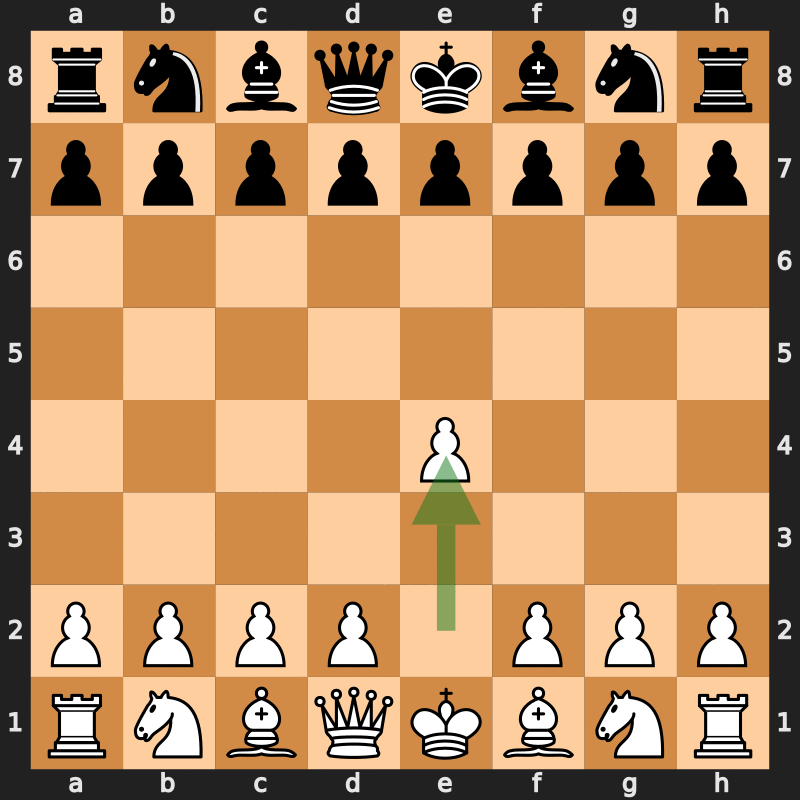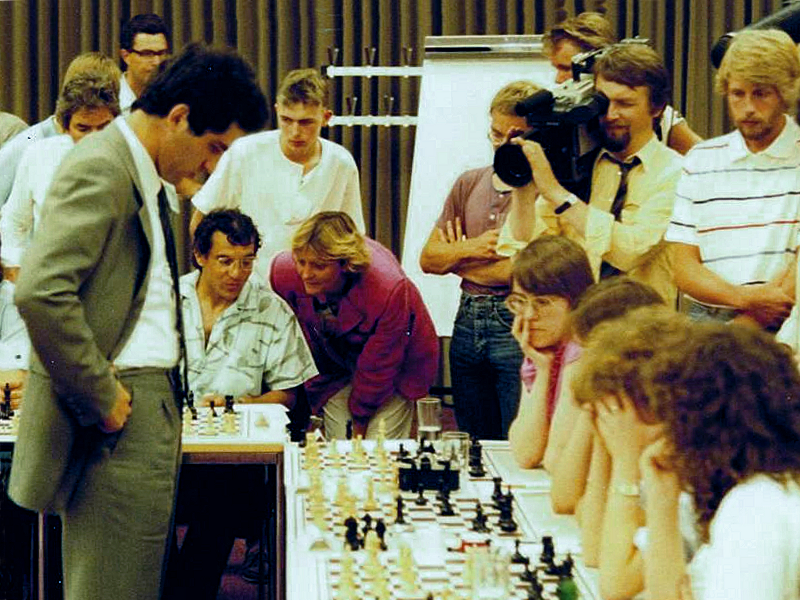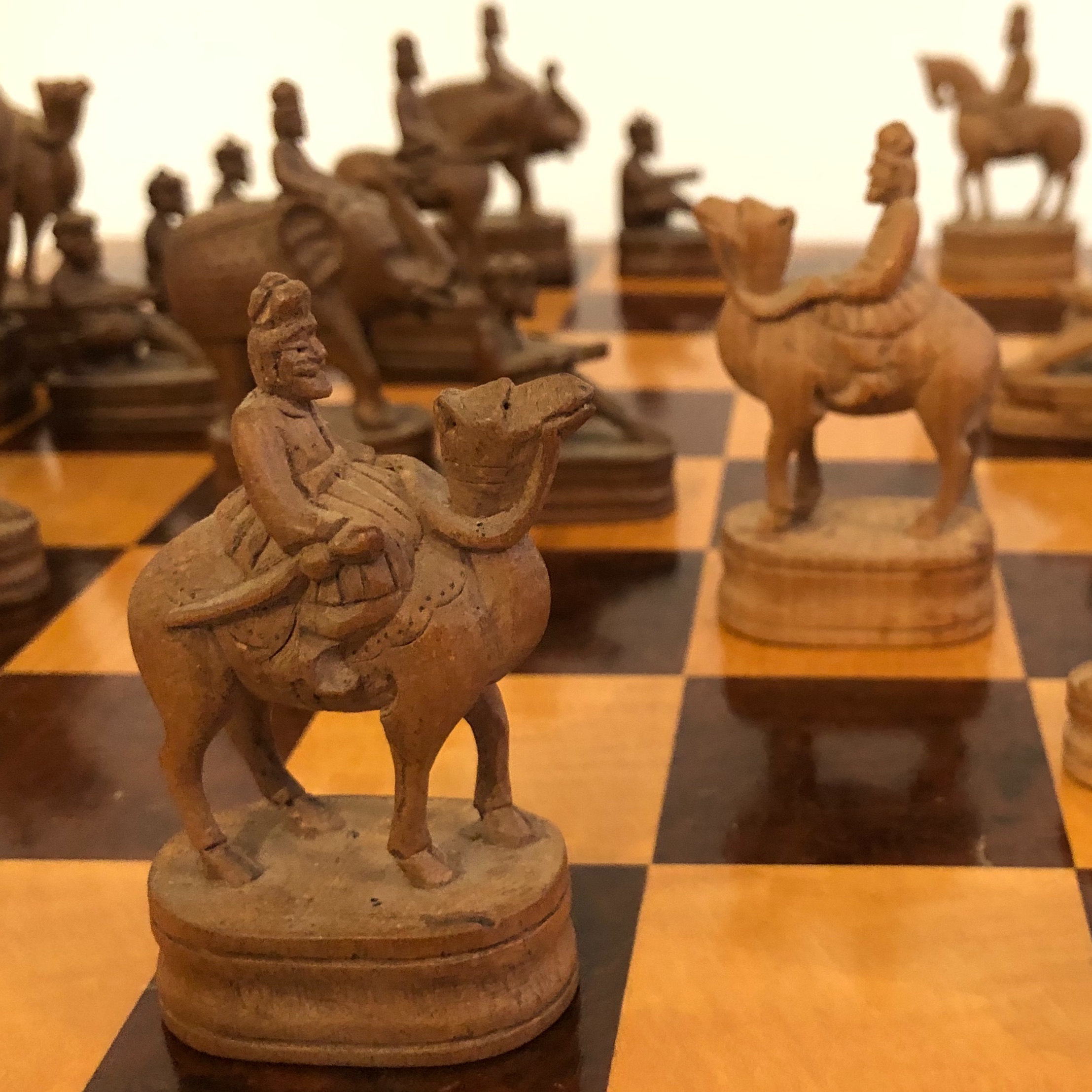|
Deep Blue - Kasparov, 1997, Game 6
Game 6 of the Deep Blue–Kasparov rematch, played in New York City on May 11, 1997 and starting at 3:00 p.m. Eastern Time Zone, EDT, was the last chess game in the 1997 rematch of Deep Blue versus Garry Kasparov. Deep Blue (chess computer), Deep Blue had been further strengthened from the previous year's match with Garry Kasparov, Kasparov and was unofficially nicknamed "Deeper Blue". Before this game the score was tied at 2½–2½: Kasparov had won the first game, lost the second game, and drawn games 3, 4, and 5 (after having advantageous positions in all three). The loss marked the first time that a computer had defeated a World Champion in a match of several games. This, as well as the fact that Kasparov had lasted only 19 moves in a game lasting barely more than an hour, attracted much media attention. The game White: Deep Blue Black: Kasparov Chess opening, Opening: Caro–Kann Defense, Steinitz Variation (''Encyclopaedia of Chess Openings, ECO'' B17 (chess o ... [...More Info...] [...Related Items...] OR: [Wikipedia] [Google] [Baidu] |
Deep Blue (chess Computer)
Deep Blue was a chess-playing expert system run on a unique purpose-built IBM supercomputer. It was the first computer to win a game, and the first to win a match, against a reigning world champion under regular time controls. Development began in 1985 at Carnegie Mellon University under the name ChipTest. It then moved to IBM, where it was first renamed Deep Thought, then again in 1989 to Deep Blue. It first played world champion Garry Kasparov in a six-game match in 1996, where it lost four games to two. It was upgraded in 1997 and in a six-game re-match, it defeated Kasparov by winning three games and drawing one. Deep Blue's victory is considered a milestone in the history of artificial intelligence and has been the subject of several books and films. History While a doctoral student at Carnegie Mellon University, Feng-hsiung Hsu began development of a chess-playing supercomputer under the name ChipTest. The machine won the North American Computer Chess Champio ... [...More Info...] [...Related Items...] OR: [Wikipedia] [Google] [Baidu] |
Knight (chess)
The knight (♘, ♞) is a piece in the game of chess, represented by a horse's head and neck. It moves two squares vertically and one square horizontally, or two squares horizontally and one square vertically, jumping over other pieces. Each player starts the game with two knights on the b- and g-, each located between a rook and a bishop. Movement Compared to other chess pieces, the knight's movement is unique: it moves two squares vertically and one square horizontally, or two squares horizontally and one square vertically (with both forming the shape of a capital L). When moving, the knight can jump over pieces to reach its destination. Knights capture in the same way, replacing the enemy piece on the square and removing it from the board. A knight can have up to eight available moves at once. Knights and pawns are the only pieces that can be moved in the chess starting position. Value Knights and bishops, also known as , have a value of about three pawns. Bishops u ... [...More Info...] [...Related Items...] OR: [Wikipedia] [Google] [Baidu] |
Computer Chess
Computer chess includes both hardware (dedicated computers) and software capable of playing chess. Computer chess provides opportunities for players to practice even in the absence of human opponents, and also provides opportunities for analysis, entertainment and training. Computer chess applications that play at the level of a chess master or higher are available on hardware from supercomputers to smart phones. Standalone chess-playing machines are also available. Stockfish, GNU Chess, Fruit, and other free open source applications are available for various platforms. Computer chess applications, whether implemented in hardware or software, utilize different strategies than humans to choose their moves: they use heuristic methods to build, search and evaluate trees representing sequences of moves from the current position and attempt to execute the best such sequence during play. Such trees are typically quite large, thousands to millions of nodes. The computational speed ... [...More Info...] [...Related Items...] OR: [Wikipedia] [Google] [Baidu] |
Chess Games
Chess is a board game for two players, called White and Black, each controlling an army of chess pieces in their color, with the objective to checkmate the opponent's king. It is sometimes called international chess or Western chess to distinguish it from related games, such as xiangqi (Chinese chess) and shogi (Japanese chess). The recorded history of chess goes back at least to the emergence of a similar game, chaturanga, in seventh-century India. The rules of chess as we know them today emerged in Europe at the end of the 15th century, with standardization and universal acceptance by the end of the 19th century. Today, chess is one of the world's most popular games, played by millions of people worldwide. Chess is an abstract strategy game that involves no hidden information and no use of dice or cards. It is played on a chessboard with 64 squares arranged in an eight-by-eight grid. At the start, each player controls sixteen pieces: one king, one queen, two rooks, ... [...More Info...] [...Related Items...] OR: [Wikipedia] [Google] [Baidu] |
Deep Blue Versus Kasparov, 1996, Game 1
Deep Blue–Kasparov, 1996, Game 1 is a famous chess game in which a computer played against a human being. It was the first game played in the 1996 Deep Blue versus Garry Kasparov match, and the first time that a chess-playing computer defeated a reigning world champion under normal chess tournament conditions (in particular, standard time control; in this case 40 moves in two hours). Overview Deep Blue was a computer developed by IBM to beat grandmaster Garry Kasparov, the top chess player in the world at the time according to Elo ratings. Playing White, Deep Blue won this first game in the match on February 10, 1996, in Philadelphia, Pennsylvania. Kasparov rebounded over the next five games, winning three and drawing two, to soundly beat the machine in the 1996 match. The game White: Deep Blue Black: Kasparov Opening: Sicilian Defense, Alapin Variation ('' ECO'' B22) 1. e4 c5 2. c3 :It is more common to play 2.Nf3, but Kasparov has deep experience with that line, so ... [...More Info...] [...Related Items...] OR: [Wikipedia] [Google] [Baidu] |
List Of Chess Games
This is a list of notable chess games sorted chronologically. pre-1700 * 1475: Castellví– Vinyoles, Valencia 1475. The first documented chess game played with the modern queen and bishop moves; the moves were described in the poem Scachs d'amor. * 1623: Greco–NN, London 1623. Gioachino Greco mates on the eighth move with a queen sacrifice. 18th century * 1788: Bowdler–Conway, London. Thomas Bowdler offers the first example of a famous double rook sacrifice. * 1790: Smith–Philidor, London. François-André Danican Philidor, who was quoted as saying "Pawns are the soul of chess", demonstrates the power of a superior pawn formation. 19th century * 1834: La Bourdonnais–McDonnell, 50th Match Game, London. Reuben Fine in ''The World's Great Chess Games'' describes it as the first great immortal game of chess. McDonnell sacrifices his queen for two minor pieces. * 1834: La Bourdonnais–McDonnell, 62nd Match Game, London. Perhaps the most famous win of the ma ... [...More Info...] [...Related Items...] OR: [Wikipedia] [Google] [Baidu] |
Raymond Keene
Raymond Dennis Keene (born 29 January 1948) is an English chess grandmaster, a FIDE International Arbiter, a chess organiser, and a journalist and author. He won the British Chess Championship in 1971, and was the first player from England to earn a Grandmaster norm, in 1974. In 1976 he became the second Englishman (following Tony Miles) to be awarded the Grandmaster title, and he was the second British chess player to beat an incumbent World Chess Champion (following Jonathan Penrose's defeat of Mikhail Tal in 1961). He represented England in eight Chess Olympiads. Keene retired from competitive play in 1986 at the age of thirty-eight, and is now better known as a chess organiser, columnist and author. He was involved in organising the 1986, 1993 and 2000 World Chess Championships; and the 1997, 1998 and 1999 Mind Sports Olympiads;William Hartston, "No rest from mental fight", ''The Independent'', 23 August 199retrieved 13 October 2011 all held in London. He was the ches ... [...More Info...] [...Related Items...] OR: [Wikipedia] [Google] [Baidu] |
Pawn Structure
In a game of chess, the pawn structure (sometimes known as the pawn skeleton) is the configuration of pawns on the chessboard. Because pawns are the least mobile of the chess pieces, the pawn structure is relatively static and thus plays a large role in determining the strategic character of the position. General observations Weaknesses in the pawn structure, such as isolated, doubled, or backward pawns and , once created, are usually permanent. Care must therefore be taken to avoid them (but there are exceptions—for instance see ''Boleslavsky hole'' below). In the absence of these structural weaknesses, it is not possible to assess a pawn formation as good or bad—much depends on the position of the pieces. The pawn formation does determine the overall strategies of the players to a large extent, however, even if arising from unrelated openings. Pawn formations symmetrical about a vertical line (such as the ''e5 Chain'' and the ''d5 Chain'') may appear similar, but they te ... [...More Info...] [...Related Items...] OR: [Wikipedia] [Google] [Baidu] |
Bishop (chess)
The bishop (♗, ♝) is a piece in the game of chess. It moves and captures along without jumping over intervening pieces. Each player begins the game with two bishops. One starts between the and the king, the other between the and the queen. The starting squares are c1 and f1 for White's bishops, and c8 and f8 for Black's bishops. Placement and movement The king's bishop is placed between the king and the king's knight, f1 for White and f8 for Black; the queen's bishop is placed between the queen and the queen's knight, c1 for White and c8 for Black. The bishop has no restrictions in distance for each move but is limited to diagonal movement. It cannot jump over other pieces. A bishop captures by occupying the square on which an enemy piece stands. As a consequence of its diagonal movement, each bishop always remains on one square color. Due to this, it is common to refer to a bishop as a light-squared or dark-squared bishop. Comparison – other pieces Versus rook A ... [...More Info...] [...Related Items...] OR: [Wikipedia] [Google] [Baidu] |
Queen (chess)
The queen (♕, ♛) is the most powerful piece in the game of chess. It can move any number of squares vertically, horizontally or , combining the powers of the rook and bishop. Each player starts the game with one queen, placed in the middle of the first next to the king. Because the queen is the strongest piece, a pawn is promoted to a queen in the vast majority of cases. The predecessor to the queen is the '' ferz'', a weak piece only able to move or capture one step diagonally, originating from the Persian game of shatranj. The modern queen gained its power and its modern move in Spain in the 15th century during Isabella I's reign, perhaps inspired by her great political power. Placement and movement The white queen starts on d1, while the black queen starts on d8. With the chessboard oriented correctly, the white queen starts on a white square and the black queen starts on a black square—thus the mnemonics "queen gets her color", "queen on er wncolor", or "t ... [...More Info...] [...Related Items...] OR: [Wikipedia] [Google] [Baidu] |
Castling
Castling is a move in chess. It consists of moving the king two squares toward a rook on the same and then moving the rook to the square that the king passed over. Castling is permitted only if neither the king nor the rook has previously moved; the squares between the king and the rook are vacant; and the king does not leave, cross over, or finish on a square attacked by an enemy piece. Castling is the only move in chess in which two pieces are moved at once. Castling with the is called ''kingside castling'', and castling with the is called ''queenside castling''. In both algebraic and descriptive notations, castling kingside is written as 0-0 and castling queenside as 0-0-0. Castling originates from the ''king's leap'', a two-square king move added to European chess between the 14th and 15th centuries, and took on its present form in the 17th century. Local variations in castling rules were common, however, persisting in Italy until the late 19th century. Castling does ... [...More Info...] [...Related Items...] OR: [Wikipedia] [Google] [Baidu] |
King (chess)
The king (♔, ♚) is the most important piece in the game of chess. It may move to any adjoining square; it may also perform a move known as castling. If a player's king is threatened with capture, it is said to be in check, and the player must remove the threat of on the next move. If this cannot be done, the king is said to be in checkmate, resulting in a loss for that player. A player cannot make any move that places their own king in check. Despite this, the king can become a strong offensive piece in the endgame or, rarely, the middlegame. In algebraic notation, the king is abbreviated by the letter K among English speakers. The white king starts the game on e1; the black king starts on e8. Unlike all other pieces, only one king per player can be on the board at any time, and the kings are never removed from the board during the game. Placement and movement The white king starts on e1, on the first to the right of the queen from White's perspective. The black king ... [...More Info...] [...Related Items...] OR: [Wikipedia] [Google] [Baidu] |







